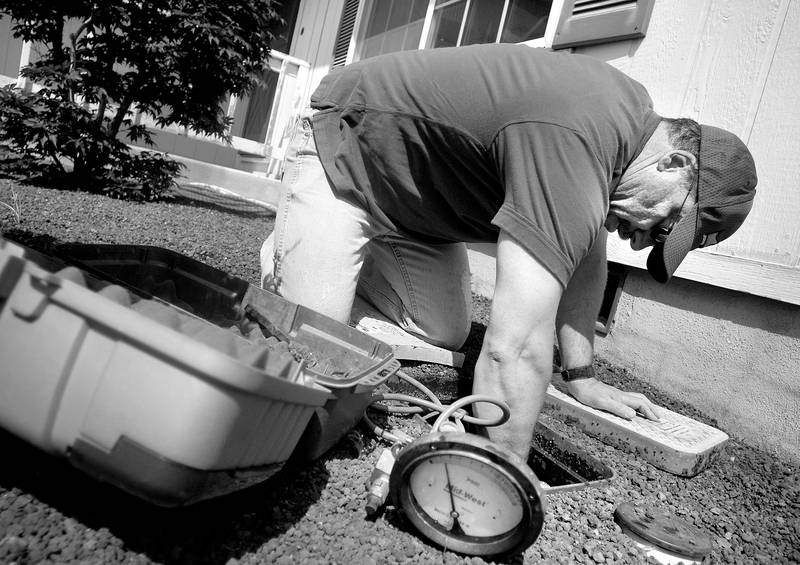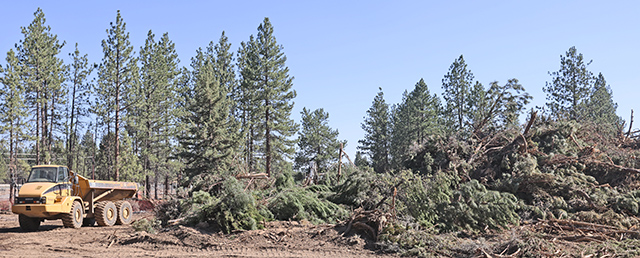Bend promotes backflow testing
Published 5:00 am Monday, May 21, 2007

- Jim Brown, of Backflow Testing Services in Bend, connects testing equipment to a backflow assembly Friday at a home in Bend. The tests are supposed to be conducted yearly, but many people don't know they are required. A broken backflow assembly can let contaminated water from a yard flow into a home's water supply.
It’s buried in thousands of yards across Central Oregon, and many people don’t even know it’s there.
Yet the backflow preventer attached to your sprinkler system helps keep your drinking water clean.
Trending
Without it, insecticides, feces and chemicals in your yard could get into the water you drink. When the backflow device fails, your water may turn cloudy – or worse, make you sick.
The city of Bend is expanding its efforts to make sure all these devices are inspected each year. But officials are finding that many people don’t know what they are, let alone the last time they were inspected.
”There’s a lot of folks in town that don’t even realize they have these backflow assemblies installed on their properties,” said Ric Olson, Bend’s safe drinking water program coordinator. ”It’s not real sexy, it’s not one that you hear about a lot, and that’s what we’re trying to remedy.”
The city is steadily building a database of who has the devices. Last year 14,000 homes and businesses were on the list, but Olson believes there are several thousand more the city doesn’t yet know about.
Federal law requires the devices be installed and tested regularly. In turn, states keep track by requiring yearly reports from cities. Many cities, including Bend, now install them by water meters to protect the city’s water supply. But a second assembly must be installed and tested whenever there is a sprinkler system or boiler on the property, for example.
Since the city of Bend doesn’t inspect the devices itself, officials agree it’s up to consumers to do the research to find a reputable inspector.
Trending
‘I need to get my what tested?’
Chances are, your home or business has at least one backflow assembly installed somewhere. If there is a ground irrigation system, fire sprinkler system or just a garden hose outlet, there is a backflow preventer nearby. They take many different forms and may be above ground or buried in small boxes with just a cover showing on the ground.
The purpose of such devices is simple enough: To keep water that is already in your irrigation pipes when your sprinklers are off, for example, from mixing with water that would come out of your kitchen sink or go into your freezer’s ice maker.
”With an underground sprinkler system, those sprinkler heads are right at ground level,” said Jim Brown, the owner of Backflow Testing Services in Bend. ”They can actually create a suctioning device when the sprinklers are turned off.”
Backflow assemblies are mechanical, relying on differences in water pressure or springs to stop water from flowing the wrong way through pipes.
If your backflow preventer stops working, there won’t be any obvious way to tell – no shrieking alarm, warning flag or glow-in-the-dark water coming through your faucets. The water will keep flowing, though it may be contaminated with fertilizer, insecticide or anything else in your yard.
That’s why getting them inspected yearly is so important, experts agree.
Olson said he regularly fields calls from residents who have gotten a letter from the city or a notice from an inspection company that they need to have their backflow preventer tested.
”I need to get my what tested?” is a common refrain, Olson said.
”It’s not a finger-thumping-the-table thing,” he said. ”It’s to protect your drinking water.”
Getting inspections
Depending on how you get your water, you may need to hire someone to test your backflow device each year. Bend residents who get their water from Avion Water Co. have the cost of yearly testing folded into their bills and don’t have to do anything else. But residents who pay the city directly for their water need to find someone to do the tests.
Olson estimates the city is missing about 4,000 properties from its database of backflow preventers.
That’s where people like Brown come in, scouring neighborhoods to help the city complete it.
”They are the best friend our program has,” Olson said, though he added that the city doesn’t endorse one particular testing company over any other. ”These guys are the front-line guys as far as getting these things physically tested.”
Olson said the city also relies on real estate agents’ disclosure forms, which often list whether a house has a backflow preventer.
Figuring out who is likely to have a backflow preventer is straightforward for inspectors like Brown.
”What I do is go into neighborhoods that look like they have manicured lawns,” Brown said. ”That tells me most of those people in that neighborhood have an underground sprinkler system.”
Commercial properties are slightly different, since their backflow assemblies must be tested before getting a certificate of occupancy. From then on, the business is in the city’s database.
When Brown started inspecting backflow devices in one Bend housing development recently, he found that eight of about 60 failed the test and needed to be replaced.
”Those failed primarily because they froze, and it cracked the bodies,” Brown said.
The solution to prevent the devices from freezing is simple enough: Brown puts Styrofoam packing peanuts in bags and surrounds the backflow device in its underground box.
Other times, the source of the failure is much more benign. It could be something small, like a pebble, that makes its way into the assembly and jams open one of the valves.
Problems like that crop up in about 10 percent of the assemblies that Brown tests. That’s a relatively high percentage, Brown said.
For a residential inspection, Brown said, the price ranges from $35 to $50.
Most testing services, Brown’s included, aren’t licensed to actually fix devices that need to be repaired. That’s up to either a plumber or a licensed landscape contractor, Brown said.
The repairs can be costly, since a new backflow preventer is about $100 plus installation. The alternative, Brown said, is that homeowners can disassemble their own device, remove whatever is causing the obstruction, reassemble the backflow preventer and then have it tested again.
Confusion for consumers?
Though the people who do backflow testing must be licensed with either the state Construction Contractors Board or Landscape Contractors Board, neither one holds much enforcement authority over the people doing the tests, state officials said. That power rests with the public health division of the state Department of Human Services, since it certifies backflow testers to make sure they know what they are doing.
For consumers, that means a little more legwork is required to figure out if the tester they’ve hired is properly licensed.
The state keeps an updated list of every tester that is certified, a 19-page document with names, phone numbers and addresses. Homeowners must check with both the construction and landscaping contractors boards to see if a person on the list is licensed.
The city of Bend also keeps a list of backflow testers, though it only includes companies that requested to be on the list.
If homeowners aren’t sure if they have a backflow device installed or if it has been tested recently, it doesn’t hurt to find an inspector who can quickly assess what’s in the ground, Olson said.
”If you don’t have a device, then there’s a possibility of contaminating at least your drinking water on your property,” Brown said.






